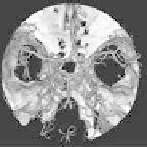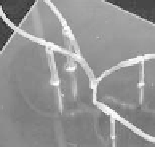Biomedical Engineering Reference
In-Depth Information
3.11.1 Preparation
Vascular models of ive cases of conventional cerebrovascular disease
were constructed for this modeling technique evaluation. All these
representative cases have an aneurysm. To compare the difference
in clinical, the following aneurysms, which have different size and
generation part, were selected for modeling. For the comparison of
vessel deformation reproduction and the necessary characteristics
required for surgical simulation in models with solid and
membranous structure, a model of each type was produced for each
case. The medical imaging data used for the models construction,
the solid structure models and the membranous structure models
for all cases are shown in Figs. 3.21-3.25. Table 3.1 summarizes
the dimensions of the aneurysms and other characteristics for each
case.
Table 3.1
Case study description
Case 1
Case 2
Case 3
Case 4
Case 5
Aneurysm type
BT
BT
BT
Left MCA
Left MCA
Mean diameter (mm)
4.3
6.8
3.1
3.8
6.9
Length (mm)
4.79
6.64
3.20
3.09
—
Breadth (mm)
3.85
7.01
3.02
4.61
—
Neck (mm)
3.10
4.15
3.73
2.91
—
Diameter 1 (mm)
————
6.68
Diameter 2 (mm)
————
7.14
Age (years)
55
45
73
78
59
Sex
Female
Female
Female
Male
Male
a)
b)
c)
d)
Figure 3.21
Case 1: BT aneurysm: (a, b) Medical imaging data. (c) Block
model. (d) Membranous model.

























































Search WWH ::

Custom Search